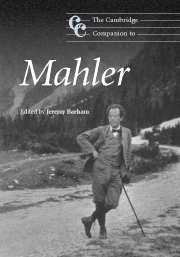Book contents
- Frontmatter
- Introduction: Marginalia on Mahler today
- PART ONE Cultural contexts
- PART TWO Mahler the creative musician
- PART THREE Mahler the re-creative musician
- PART FOUR Reception and performance
- 12 Issues in Mahler reception: historicism and misreadings after 1960
- 13 The history of the International Gustav Mahler Society in Vienna and the Complete Critical Edition
- 14 Musical languages of love and death: Mahler's compositional legacy
- 15 Mahler conducted and recorded: from the concert hall to DVD
- 16 New research paths in criticism, analysis and interpretation
- Appendix: selected discography
- Notes
- Bibliography
- Index
12 - Issues in Mahler reception: historicism and misreadings after 1960
from PART FOUR - Reception and performance
Published online by Cambridge University Press: 28 September 2011
- Frontmatter
- Introduction: Marginalia on Mahler today
- PART ONE Cultural contexts
- PART TWO Mahler the creative musician
- PART THREE Mahler the re-creative musician
- PART FOUR Reception and performance
- 12 Issues in Mahler reception: historicism and misreadings after 1960
- 13 The history of the International Gustav Mahler Society in Vienna and the Complete Critical Edition
- 14 Musical languages of love and death: Mahler's compositional legacy
- 15 Mahler conducted and recorded: from the concert hall to DVD
- 16 New research paths in criticism, analysis and interpretation
- Appendix: selected discography
- Notes
- Bibliography
- Index
Summary
Methodological considerations
The reception history of a composer comprises the sum of inherited accounts, condensed over time into a reflection of that person and his or her work. It is defined by all existing sources and testimonies, some of which are handed down without question while others are critically scrutinized. Changes in historically recorded contexts and revisions of aesthetic judgements are rare. In such cases reception history can have a corrective function and can uncover and identify processes of evaluation. Up to the early 1990s, research in reception history was developed in German-speaking musicology with the aim of describing anew the interplay between author, text and reader, or between composer, work and listener. At the heart of this lay questions involving aesthetic expectations and their fulfilment. Whilst at the beginning of the 1990s such research was still seen as a forward-looking model for new academic practice, it has not yet established itself accordingly. In this context Mahler reception history offers a prototype for investigations which reveal a dramatic picture of scholarly history over long stretches of time. Indeed Carl Dahlhaus refers to the special status of research into Mahler reception as a ‘history of events’.
Through this, the interplay between institutions and individuals responsible for handing down traditions can be clarified. Preconditions for this type of almost Foucauldian archaeological investigation are the comprehensive research, analysis and evaluation of source materials from different institutions. For example, it has been possible to reconstruct from these the course of almost one hundred years in the performance history of the Third Symphony.
- Type
- Chapter
- Information
- The Cambridge Companion to Mahler , pp. 201 - 216Publisher: Cambridge University PressPrint publication year: 2007

